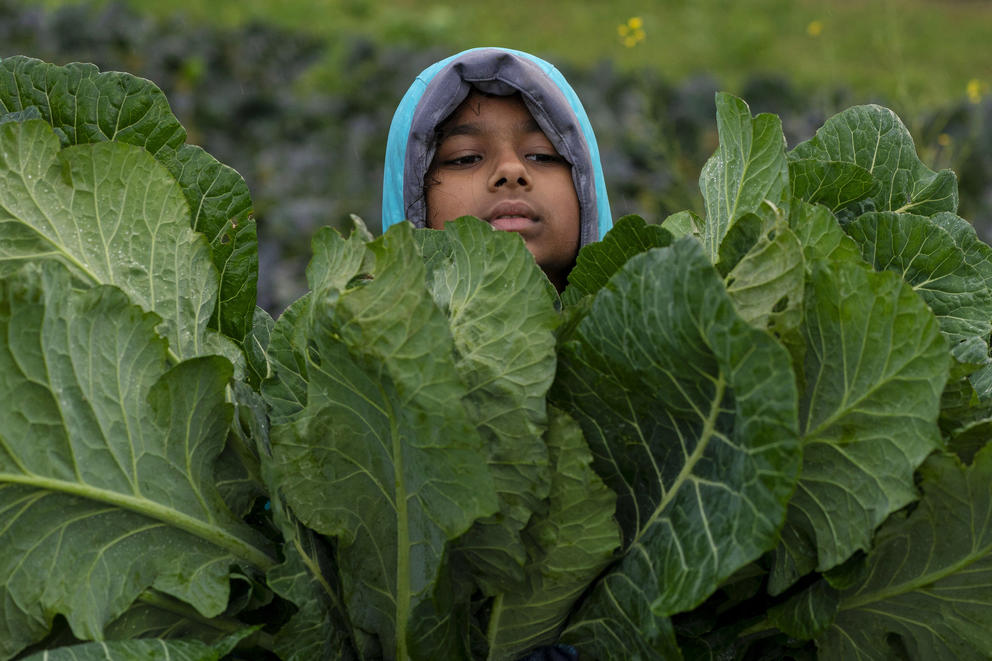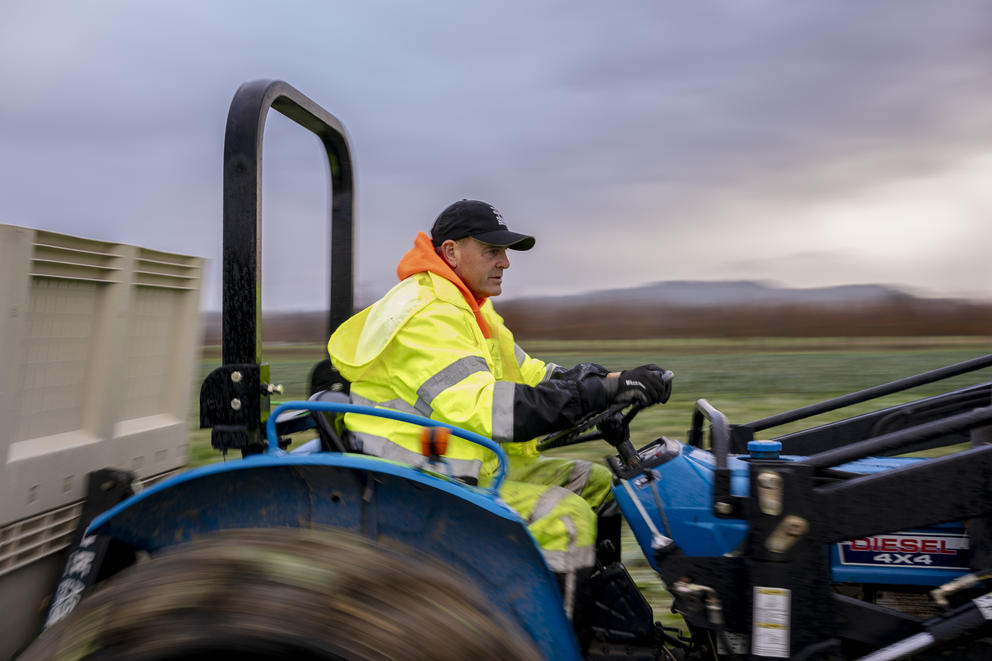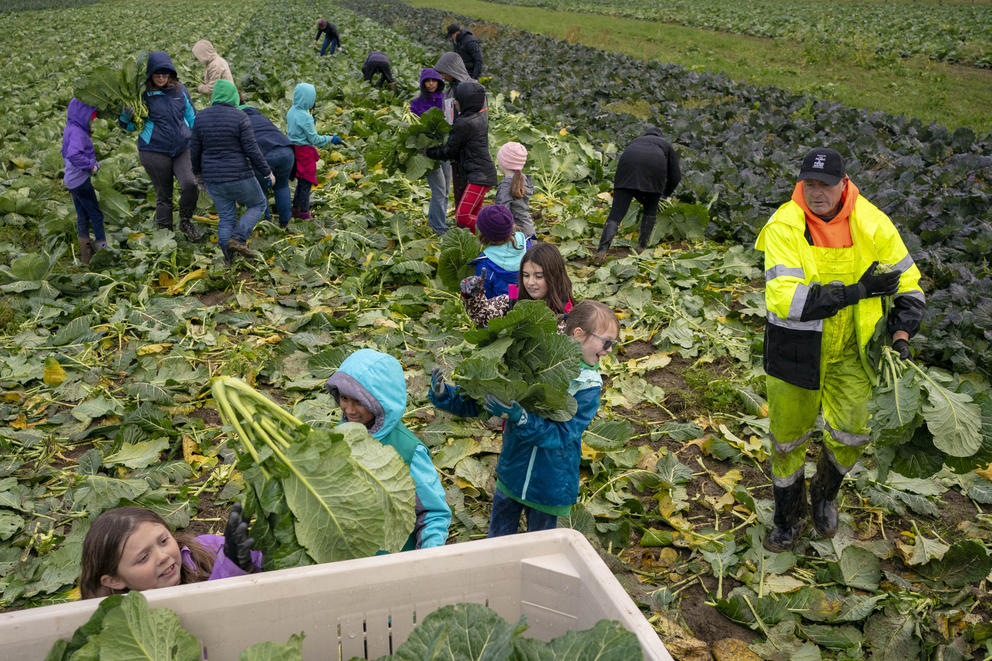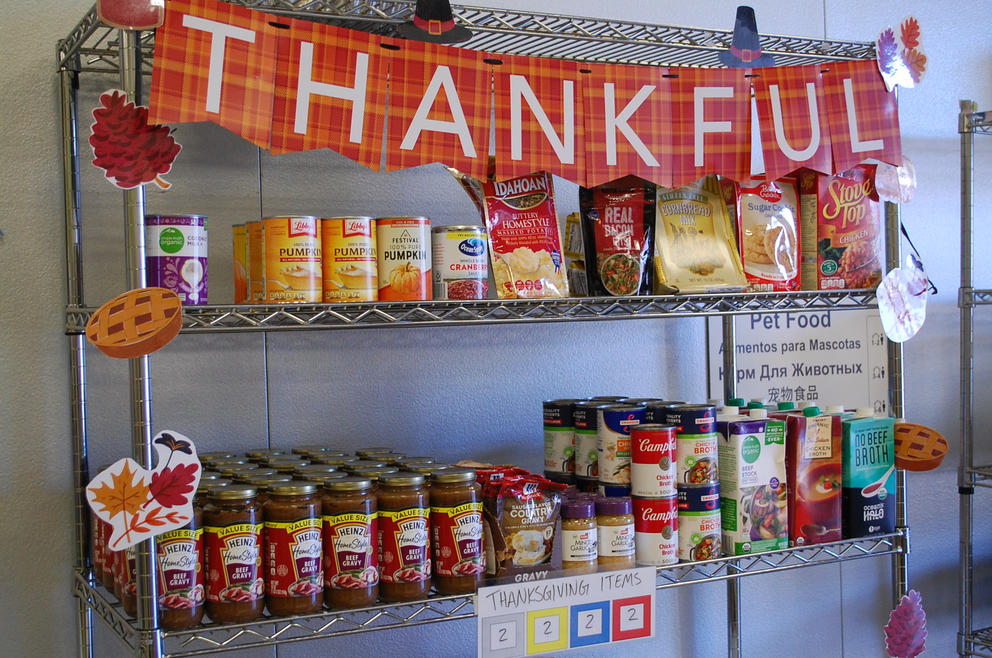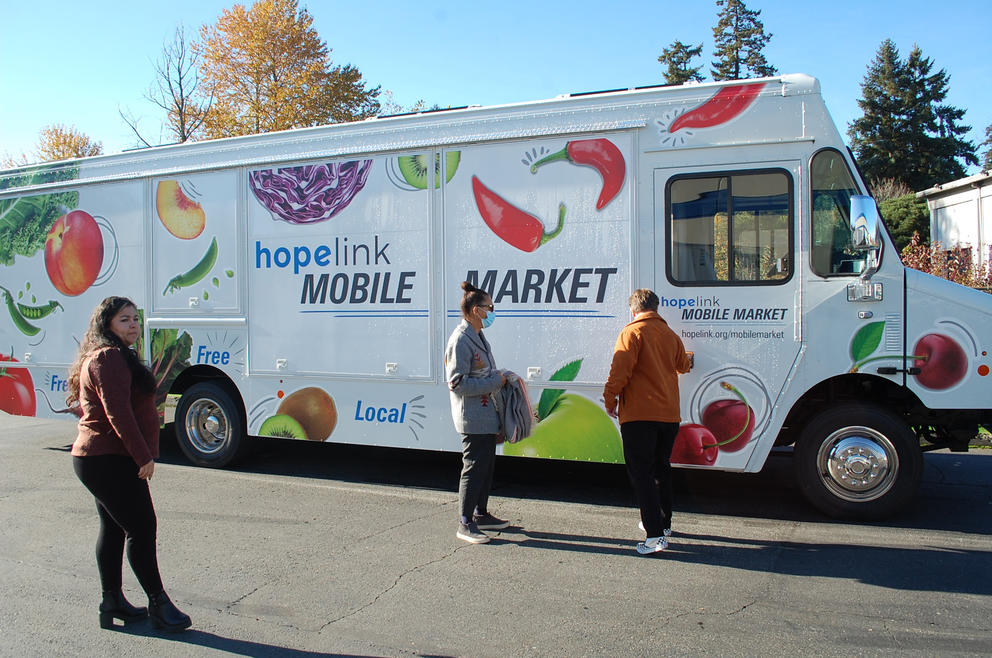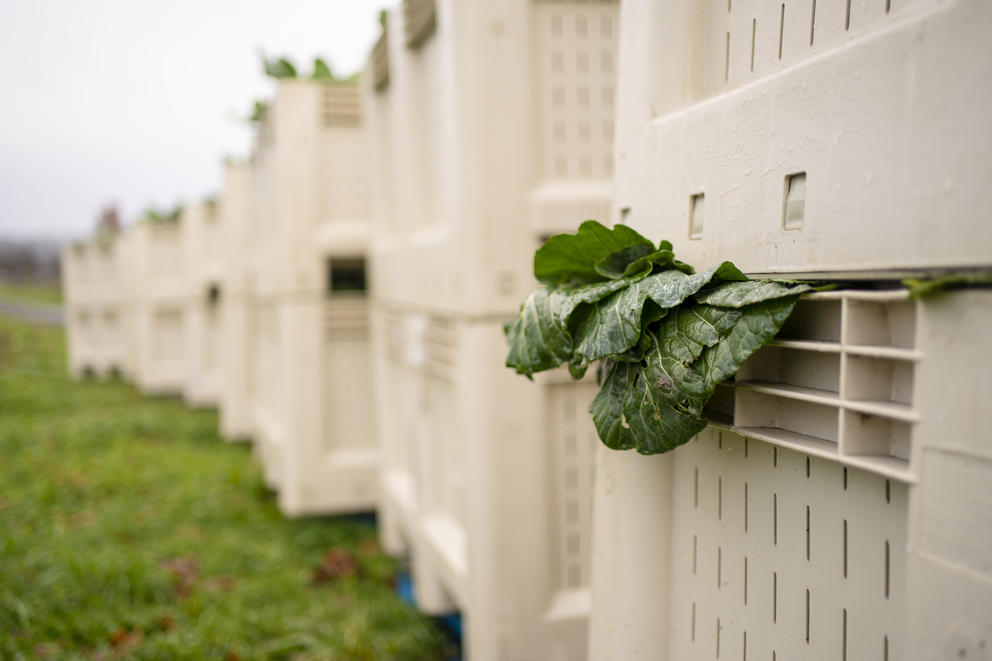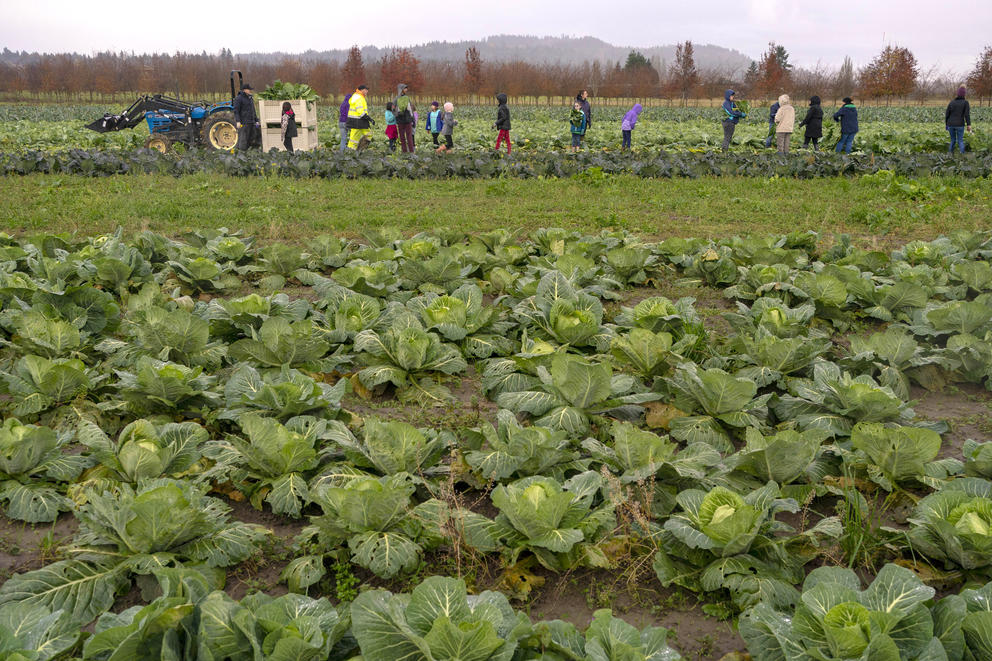With food, gas and housing costs rising in east King County at a rate much higher than the rest of the state, the number of residents who have difficulty paying for basic needs is surprisingly high. Despite its reputation as a place with abundant tech money and the mansions of software executives, east King County also has nearly 29,000 households without enough income to cover basics such as food, housing and child care, according to data from the Center for Women’s Welfare at the University of Washington.
Pockets of poverty and food deserts
“Our community needs assessment tells us is that it takes 400 percent of the federal poverty level to meet your basic needs here in King County,” said Meghan Altimore, vice president of community services at Hopelink, which operates five food banks in Kirkland, Bellevue, Redmond, Carnation and Shoreline. In addition, it operates a mobile free grocery that travels around rural areas and places with few options for inexpensive food.
Annie Kucklick, a researcher at UW’s Center for Women’s Welfare, believes federal poverty guidelines are an outdated and ineffective measure of economic vulnerability in places like east King County, where costs are much higher than the national average.
In the early 2000s, the UW Center created a new measure, the Self-Sufficiency Standard, which takes into account variable costs by region and seeks to create a more accurate snapshot of the real cost of food, housing, transportation, health care and child care. Kucklick said that the total of those basic costs for a family of four is $119,706 in east King County – the highest rate of any region in the state.
“What we see in Washington is that a large percentage of households who are not making ends meet have at least one full-time worker in the household,” Kucklick said, noting that for many, incomes haven’t risen as fast as costs. According to the Center’s latest data, about 12 percent of people in east King County can’t meet their basic costs – and rising food costs are certainly part of that equation.
Even though that rate is much lower than in, say, southwest King County, where it’s 38 percent, that 12 percent figure still represents a significant hidden population that struggles to pay for the basics. “These people are not invisible,” Kucklick said. “They’re being specifically ignored because the systems that are set up to support families are often based on the federal poverty guidelines, which are so low.”
Altimore said that it’s common to find immigrants, refugees and people of color living in crowded households on the Eastside to save money – and to avoid having to travel long distances to where they work, which can be expensive because of high gasoline prices. “Those households don’t qualify as homeless or unhoused because they do have a roof over their head,” she said. “But you can have literally 16 people living in a two-bedroom apartment.”
Each Hopelink food center serves a variety of ethnic communities, Altimore said. The Bellevue location sees a sizable Russian and Ukrainian population while Carnation’s serves a large Latino community. Other large language groups served by Hopelink include Mandarin Chinese, Arabic, Farsi and Korean.
In addition, she says that in the past six months, Portuguese has soared into the top five languages spoken by clients at Hopelink’s Kirkland location – “We have a large Brazilian population in the city of Kirkland,” Altimore said.
Phoebe Sandock, a food programs supervisor at the Kirkland site, said that the food bank’s staff visited a number of Brazilian markets in the area to get a better sense of what that community prefers in terms of food. “Their diets have a lot of seafood,” she said. “So we try to keep a lot of canned seafood around that’s not just tuna. Plus potatoes, onions, peppers and citrus. And tomatoes. Tomatoes are big, big, big, big.”
Hopelink stocks a wide variety of non-perishable staples like beans and peanut butter, some fresh produce, and occasionally meats and milk products. Sandock said the center aims to provide a selection of about 90 percent of a client’s food needs. “We’re able to save a family about $450 a month when they come here,” said Amanda Lopez-Castañon, food programs director at Hopelink.
Hopelink’s new mobile food market (known affectionately as “Herbie”) is still shiny and new after being tricked out in a shop in Oregon with industrial refrigerators, rainproof awnings, and abundant shelf space to stock the same products as its brick-and-mortar locations. Lopez-Castañon said the van, made possible by a grant from the Washington State Department of Agriculture, will start visiting locations across east King County soon after Thanksgiving.
She notes that even an organization on Mercer Island – not a place generally associated with people living in poverty – has requested a stop by Hopelink’s van. “That stop is going to be 150 people every two weeks. I guess we’ll find out just exactly what that population is,” she said.
Not only have food costs risen over the past few years on the Eastside, but affordable options are limited. “In some of these suburban areas there are just high-end grocery stores and then McDonald's,” said Cade Schmidt, communications director for Hopelink.
With Thanksgiving just around the corner, it’s clear from a quick visit to the two grocery stores closest to the Kirkland Hopelink that creating a traditional Thanksgiving meal is an expensive proposition. At the local Whole Foods, for instance, the cheapest frozen turkeys run $1.99 per pound, easily totaling $30 or more for a full-size turkey. You can find a fancy premade pumpkin pie for around $15; or if you want to make your own, a can of pumpkin puree will set you back $3.50.
At the other grocery store nearby, a Fred Meyer, prices aren’t quite as high, but a frozen turkey is still $1.89 per pound – at least $30 for a reasonable-sized bird. A frozen pumpkin pie will cost you $8.99, and pumpkin puree is $2.50.
Food costs have soared locally in the past 20 years, says UW’s Kucklick, putting pressure on families who have also seen rents climb to record levels According to data she and her colleagues have used to generate self-sufficiency standards, food costs in King County have risen 133 percent since 2001 and total self-sufficiency costs have increased by 267 percent in east King County – the highest rise of any region in the state.
In the Seattle area, the consumer price index (a federal cost-of-living calculation used to determine inflation rates) has risen by more than 20 percent since 2021.
A church grows and gives away food
Hopelink works to actively promote local farms, especially those owned and run by women, LGBTQ+ farmers and people of color. That list of 18 partners includes small farms such as Local Roots in Duvall, Terrebone Truck Farm in the Snoqualmie Valley and Tian Tian Farm on Vashon Island.
Hopelink also receives donations of fresh produce from Food Bank Farm, a project started by the Episcopal Church of the Holy Cross in Redmond in 2011. Pastor Jim Eichner said the organization’s 20-acre farm in Snohomish produces about 200,000 pounds of fresh produce for area food banks each year.
“We have about a thousand volunteers come out during the course of the year to plant and harvest,” Eichner said, noting that because all the farm’s labor is volunteer, it costs just five cents per pound to produce those fruits and vegetables.
“It’s a really remarkable partnership,” Altimore said of Food Bank Farm. “They actually ask us what we want them to plant.” At Hopelink’s Bellevue location, for instance, they ask Food Bank Farm for large quantities of beets and ginger to serve the market’s Russian population.
Eichner says the church’s farm grows a wide variety of produce – in summer, cucumbers and and green beans are in high demand, as well as green onions, all manner of peppers, fava beans and Asian-style eggplants. This fall, the Farm has been harvesting cabbage and broccoli as well as filling two semitrucks full of winter squash, which Eichner says is popular with a variety of cultures and keeps for a long time.
“We've got about 60,000 beets out there right now,” he said, noting that a big volunteer contingent will be working on digging them out through November. Eichner said his parishioners do Sunday harvests from July to February, when cabbages are still growing.
“We’re at the latitude of Duluth, Minnesota,” he said, “But we have the winter of Charlotte, North Carolina. So we have an incredible growing season for vegetables.”
To serve the Portuguese-speaking population in Kirkland, Eichner has investigated growing green field corn, which in Brazilian culture is slow-roasted and almost caramelized, he said. “And we’ve had people stop by and ask if they can pick the blossoms off the pumpkin plants, and the tip of the vines,” he said. “Pacific Islanders like to use those pumpkin vines for soup,” he said.
At the Hopelink food market in Kirkland, Olga has filled a shopping cart to the brim with food, including cans of beans, heads of garlic and a huge bunch of colorful chard. “This is the kind that grows in Mexico City,” she said, noting she planned to make a dish incorporating chard, rajas [roasted peppers], fried potatoes and onions.
“This market really helps a lot” in reducing her costs, she said, and allows her to continue to live near her extended family. Before she leaves, she adds some fresh flowers to her cart, which are donated to Hopelink by local groceries. “These are a blessing,” Olga said of the flowers as she wheeled her cart out the door without stopping for a cashier.

